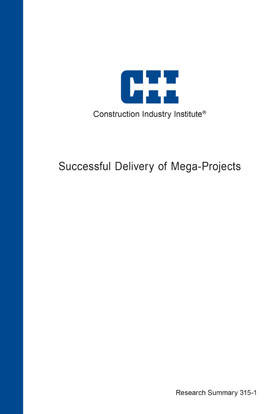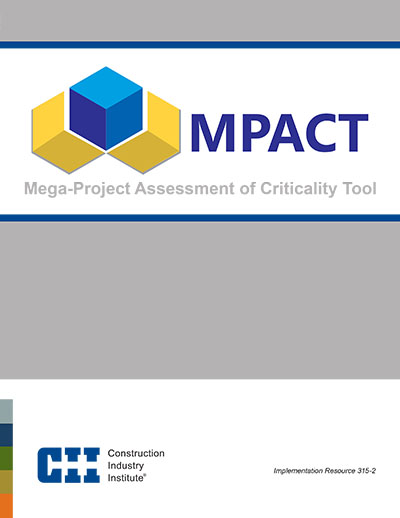
Successful Delivery of Mega-projects
Publication No
RR315-11
Type
Academic Document
Publication Date
Aug 01, 2016
Pages
523
Research Team
RT-315
DOCUMENT DETAILS
Abstract
Filters & Tags
Abstract
1.1 Problem Statement
Mega-projects in simple terms are defined as projects having a billion dollar plus budget. Megaprojects are also categorized by complexity, uncertainty, ambiguity, dynamic interfaces, significant political or external influences, and time periods reaching a decade or more (Floricel & Miller, 2001). Mega-projects are often classified in the highly complex program category facing numerous challenges and facing the most extreme project characteristics (Kardes, Ozturk, Cavusgil, & Cavusgil, 2013). Incorporating both complexity and budget criterion in the context of the research, a mega-project is defined as any project with a total installed cost greater than $1 billion dollars with one or more of the following complexity criteria: significant number of stakeholders; large number of interfaces; challenging project location; inadequate supply of resources; unfamiliar technology; difficult regulatory constraints; extensive infrastructure requirements; geographically dispersed teams; and significant political, economic, environmental, or social influence.
Mega-projects are now common in capital projects industry; witnessing a rapid rise in the size and number of mega-projects. A 2012 Schlumberger Consulting report stated that annual capital spent on oil and gas exploration and production mega-projects has more than tripled in the past 10 years, with the number of projects above $1 billion have nearly quadrupled in number (Procaccini, Lea-Cox, & Hoop,
Challenges of E&P Megaproject Delivery, 2012). Spending on infrastructure in emerging markets was estimated by Merrill Lynch to be $2.25 trillion annually between 2009 and 2012. Many other reports provide similar insights, indicating more mega-projects to come.
Given the size and scale, mega-projects are of importance not only to the stakeholders involved in development and construction, but also to the societies, economies, and environments impacted by the projects. The scale of mega-projects is so large that the failure and success of even a single project can have significant bearing on the sponsoring governments or countries (Flyvbjerg, Bruzelius, & Rothengatter, 2003). For instance, the operating problems with Hong Kong’s new US $20 billion Chek Lap Kok airport, which opened in 1998, initially caused havoc only with the costs and revenues of the airport. The problems then spread to the Hong Kong economy, with negative effects on growth in gross domestic product (CNN, Financial News, 16 July 1988). After nine months of operation, The Economist dubbed the airport a “fiasco”, said to have cost the Hong Kong economy US $600 million (The Economist, 28 August 1999). The criticality of these projects as observed by Edward Merrow in a RAND study of mega-projects quotes, “Such enormous sums of money ride on the success of mega-projects that company balance sheets and even government balance of payments accounts can be affected for years by the outcomes...The success of these projects is so important to their sponsors that firms and even governments can collapse when they fail” (Merrow E. W., Understanding the Outcomes of Megaprojects: A quantative analysis of very large civilian projects pg 2-3, March, 1988).
Despite their impact and significance, many recent studies assessing the performance of mega-projects have concluded that cost and schedule overruns are common in all industry segments and world regions. After analyzing more than 300 mega-projects, Merrow concluded that approximately 65 percent failed to achieve the performance objectives established at sanction. The results were even worse in the oil and gas sector, where close to 78 percent of the mega-projects failed (Merrow E. W., Industrial Megaprojects Concepts. Strategies, and Practices for Success, 2011). Another recent study by Ernest & Young (EY, 2014) concluded that 73 percent of the mega-projects they studied experienced schedule overruns and 64 percent had cost overruns. On average, actual costs were 59 percent higher than original estimates. The Construction Owners Association of Alberta (COAA) and others who have also studied the issue arrived at similar conclusions (McTague & Jergeas, 2002) (Slootman, 2007) (Jergeas, 2009) (Flyvbjerg, Bruzelius, & Rothengatter, 2003). By definition, mega-projects are large, complex, and problematic, with planning subject to error. Mega-project failures can be dramatic. Failure to deliver a mega-project on time, within budget, or in accordance with regulatory or environmental requirements can have major repercussions on an organization’s reputation and revenue performance (EY, 2014).
There are very few studies that provide guidance on the effective planning and execution of megaprojects. It is important to verify if some practices are more difficult to implement on mega-projects, or if there are certain practices in need of modification to suit mega-projects. Conversely, it is important to identify other practices that may be critical to the success of mega-projects. Other research has suggested that mega-projects produce a culture of optimism. On the Big Dig, Boston’s Central Artery/ Tunnel Project, the initial estimated cost was $2.56 billion, the project cost escalated to $14.8 billion in 2007. The overrun budget resulted from the unrealistic initial cost estimation (Greiman, 2013). In this regard, previous studies highlighted the importance of the project planning and the alignment between the business planning team and the project management team.
The current body of knowledge suggests that mega-projects are more sensitive to certain factors than smaller-sized projects. The capital projects industry has expanded, but it is underprepared to successfully execute mega-projects. For all the reasons mentioned above, the industry must identify what sorts of changes in project planning and execution are needed and implemented to improve the probability of success on mega-projects.
1.2 Purpose and Objective
After conducting an initial literature review it was evident that there exists a need to focus research effort into learning what factors impacts mega-projects the most and how project teams can mitigate these factors. This research project focused on adding value to the capital projects industry by contributing to the body of knowledge by providing recommendations, guidelines, and tools to successfully plan and execute mega-projects.
Based on the needs, the primary purpose of this research project was to identify and characterize changes in project planning and execution practices that are needed in order to improve the probability of successful mega-project outcomes. RT 315, composed of owners, contractors, and academic researchers, was chartered to gather data through interviews, surveys, and industry case studies to fulfill the following specific research objectives:
1. Describe the current state of practice in mega-project delivery.
The first objective was to conduct a thorough literature review for a better understanding on the practices and procedures being currently used in planning and executing mega-projects. The objective was important so as to be able to build on previous findings and add value to the overall research on mega-projects. This included learning the various definitions of mega-projects, understanding the current trends with mega-project performance, and identifying some high-level success and failure factors of mega-projects.
2. Rank the root causes of poor performance of mega projects.
The second objective focused on identifying and prioritizing factors that have higher occurrence and greater impact on mega-projects, this would help project teams focus on critical areas on their mega-project. The prioritized list will provide an industry reference for teams and provide awareness of these factors.
3. Identify changes in planning and execution practices to address these root causes and improve performance.
After identifying the primary success and failure factors on mega-projects, guidance will be provided on the planning and execution of the identified factors to enable effective mitigation. Through the findings, mega-project organizations will better understand how to address the organizational, managerial, political, cultural, environmental, social, and economical issues involved, as well as how to establish appropriate strategies.
4. Develop any appropriate tools to support proactive mega-project planning and execution.
The final objective was to develop simple tools that would help mega-project teams use the research findings to better plan for the factors identified. The tool would be a project readiness or assessment tool. The main aim behind this objective was to complement existing organization processes and help make them better fit for mega-projects. At the end, the researchers aim to provide in-depth guidance and tools for the successful delivery of mega-projects, considering the unique characteristics and challenges of this type of project.
1.3 Assumptions and Limitations
• Since the majority of respondents were in the industrial sector, the findings mainly address heavy industrial mega-projects. However, the findings may apply to other industry sectors.
• More than 100 projects participated in the data collection efforts. All participants were approached as volunteers for the study.
• The research focused on the performance of mega-projects in terms of cost, schedule, and business goals. The data gathering and analysis did not include safety and quality performance.
1.4 Organization of the report
This report will first provide a description of the research methodology adopted in Chapter 2 listing the various research steps. Chapter 3 will then describes in detail the background review conducted to explain the current state of mega-projects delivery. Chapter 4, Chapter 5, and Chapter 6 will each detail the methodology and findings of the different data collection and analyses phases. Chapter 4 will deal with preliminary interviews, Chapter 5 with survey and follow up interviews and Chapter 6 with case studies. Chapter 7 will successively present the application and implementation of the research along with information about impact factors on mega-projects. Chapter 7 will also introduce and explain the assessment tool prepared to assess the criticality of factors on mega-projects. Finally, Chapter 8 will detail the conclusions and recommendations made from the research.
Filters & Tags
Project Phase
Project Function
Industry Group
Research Topic
Successful Delivery of Mega-projects
Keywords
Criticality Tool,
Host countries,
MPACT,
Mega-projects,
rt315



